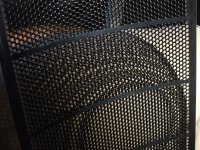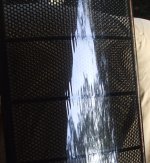There Speakers Panels were Made in 2001-2002
We have In the panels befor this time like the SL3 an others, the rubber in the spacer is thicker an softer....from 2000 on the {Lexan} is a harder rubber type.....About half as thick....one thing took a min. to get the panel pulled a part.....with No nicks in the mylar...the older panels were hard to get a part....an most of the time you would get a rip in the mylar... but most of the time you had nothing to lose....the older would lose it coting...so you had it put on High V coting to get them to work agin... sope work good grafit.. here is pix of the new panel spacer...Now with the new Mylar... it so thin if you put any coting on it you lose SPL...output drop off fast...i DONT think You can Recote..the new panles i have after a good wash an cleaning work great like new...no loss of coting after 11years....But the older panels can sound great an be recoted over an over....an the MIDs sound a littel sweeter..softer rubber....I need more time with the newer panels.
The info is from Stereophile v24n7.... vary cool maylar the highs are better than the older panes an you get more output from smaller gap.This info is for the diy in use...
MartinLogan's CLS screens are arc-proof. Sanders and his engineers determined that panel arcing was due to local buildup of charge from uneven coatings on the 0.0005"-thick polyester diaphragm. While other manufacturers hand-paint diaphragms with a conductive material, MartinLogan vapor-deposits the conductor as a 1-angstrom-thick (0.0000000001m) layer onto the diaphragm's surface. This process produces an optically transparent conducting layer with uniform characteristics of surface resistivity that prevent charge buildup and migration, and arcing. According to Sanders, this layer has the electrical surface conductivity of human skin, allowing it to hold a static charge of from 1500V to 3000V.
The Prodigy's diaphragm is sandwiched between perforated steel plates, called stators, that carry the varying audio-signal voltage while providing insulation to protect the user. A nylon-based powder insulation is deposited at very high temperatures on the perforated steel stators to provide a safety tolerance of 12kV. Fourteen evenly spaced ClearSpars, or horizontal Lexan insulators/spacers, subdivide the panel and create a uniform gap between the stators and the diaphragm. When the amplifier's audio signals are stepped up to high voltages by a transformer and applied to the stators, an electrostatic field of opposing voltages produces forward and backward movement of the diaphragm, which in turn generates sound waves in air.
One problem with electrostatic speakers has been the tendency of the charged membrane to collect dust. However, the Prodigy's diaphragm accumulates dust only slowly because it automatically shuts down its electrical field when no music is playing. When dust has accumulated, the manual advises the owner to leave the speaker unplugged for 12 hours, then vacuum the
We have In the panels befor this time like the SL3 an others, the rubber in the spacer is thicker an softer....from 2000 on the {Lexan} is a harder rubber type.....About half as thick....one thing took a min. to get the panel pulled a part.....with No nicks in the mylar...the older panels were hard to get a part....an most of the time you would get a rip in the mylar... but most of the time you had nothing to lose....the older would lose it coting...so you had it put on High V coting to get them to work agin... sope work good grafit.. here is pix of the new panel spacer...Now with the new Mylar... it so thin if you put any coting on it you lose SPL...output drop off fast...i DONT think You can Recote..the new panles i have after a good wash an cleaning work great like new...no loss of coting after 11years....But the older panels can sound great an be recoted over an over....an the MIDs sound a littel sweeter..softer rubber....I need more time with the newer panels.
The info is from Stereophile v24n7.... vary cool maylar the highs are better than the older panes an you get more output from smaller gap.This info is for the diy in use...
MartinLogan's CLS screens are arc-proof. Sanders and his engineers determined that panel arcing was due to local buildup of charge from uneven coatings on the 0.0005"-thick polyester diaphragm. While other manufacturers hand-paint diaphragms with a conductive material, MartinLogan vapor-deposits the conductor as a 1-angstrom-thick (0.0000000001m) layer onto the diaphragm's surface. This process produces an optically transparent conducting layer with uniform characteristics of surface resistivity that prevent charge buildup and migration, and arcing. According to Sanders, this layer has the electrical surface conductivity of human skin, allowing it to hold a static charge of from 1500V to 3000V.
The Prodigy's diaphragm is sandwiched between perforated steel plates, called stators, that carry the varying audio-signal voltage while providing insulation to protect the user. A nylon-based powder insulation is deposited at very high temperatures on the perforated steel stators to provide a safety tolerance of 12kV. Fourteen evenly spaced ClearSpars, or horizontal Lexan insulators/spacers, subdivide the panel and create a uniform gap between the stators and the diaphragm. When the amplifier's audio signals are stepped up to high voltages by a transformer and applied to the stators, an electrostatic field of opposing voltages produces forward and backward movement of the diaphragm, which in turn generates sound waves in air.
One problem with electrostatic speakers has been the tendency of the charged membrane to collect dust. However, the Prodigy's diaphragm accumulates dust only slowly because it automatically shuts down its electrical field when no music is playing. When dust has accumulated, the manual advises the owner to leave the speaker unplugged for 12 hours, then vacuum the
Attachments
I sead...
...i DONT think You can Recote..the new panles i have after a good wash an cleaning work great like new....
Well i thought i would get hit on the
...Cant Recote.....you CAN recote any ESL Mylar!...
Now you can an must Wash any ESL....make big Diff, get rit of Dust....
...i DONT think You can Recote..the new panles i have after a good wash an cleaning work great like new....
Well i thought i would get hit on the
...Cant Recote.....you CAN recote any ESL Mylar!...
Now you can an must Wash any ESL....make big Diff, get rit of Dust....
Hi
I bought a pair of Sequel II's very cheaply as they were not working. I had a friend pick them up and he drove them the 600km in an open pick up. He was very apologetic when he arrived as he had been caught in a rain storm. This storm did the trick as they appear to work perfectly now. They were previously at a coastal location which may have have affected the coating
I bought a pair of Sequel II's very cheaply as they were not working. I had a friend pick them up and he drove them the 600km in an open pick up. He was very apologetic when he arrived as he had been caught in a rain storm. This storm did the trick as they appear to work perfectly now. They were previously at a coastal location which may have have affected the coating
- Status
- This old topic is closed. If you want to reopen this topic, contact a moderator using the "Report Post" button.

